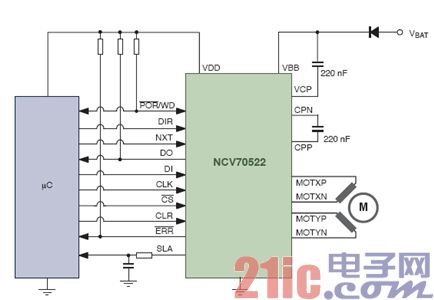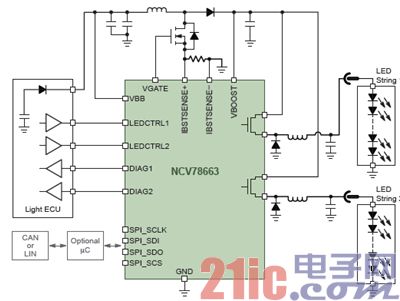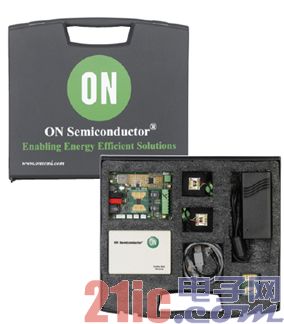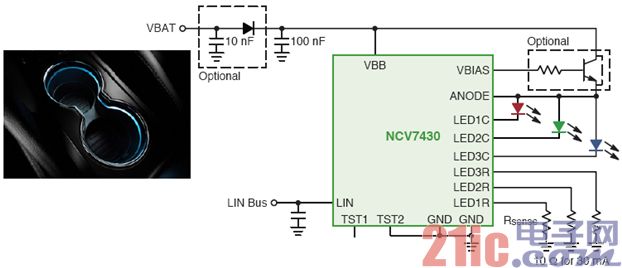As LED light output continues to increase, color and white high-brightness LEDs have been able to replace incandescent lamps for automotive lighting. Since the LED is a low voltage device, the forward voltage may be between 2 V and 4.5 V depending on the color and current; the LED also needs to be driven at a constant current to ensure the required light intensity and color. ON Semiconductor offers a wide range of LED lighting and motor drive solutions for automotive lighting applications that meet the stringent automotive requirements to meet the needs of different automotive lighting applications.
This article refers to the address: http://
Car headlight scheme
Most of the cars on the road now are equipped with halogen lamps with main headlight functions - high beam and low beam. The halogen low beam has a power consumption of approximately 55 W and provides a light output of approximately 1,000 lumens. The high-intensity discharge lamp (HID) introduced ten years ago consumes about 35 W and has a light output of about 3,500 lumens. Due to the extremely high light intensity and glare, it will bring risks to the oncoming car. In some countries, the low beam is required to be automatically adjusted and a high pressure cleaning device is added. Over time, the HID lamp will integrate the high beam function in the bi-xenon solution.
Although halogen lamp technology is still a viable headlamp solution, automotive design has begun to use LED lighting technology more and more to provide a rich selection of styling, support for "instant conduction" of lamps, and achieve 0% to 100% Brightness control.
Another important use of headlamps is to optimize the beam rotation of the adaptive headlamp system (AFS) for corner visibility and to adapt the beam to the adaptive driving beam (ADB) according to the real-time environment. The stepper motor provides the main control functions for AFS and ADB. ON Semiconductor offers a complete line of products specifically designed for headlamps, including universal lamp driver solutions, stepper motor drivers, LED drivers and xenon lamp drivers.
1) Headlight level and rotation adjustment scheme
The AMIS-30623 single-chip microstepping motor driver controller and LIN interface can be used to design a dedicated electromechanical solution for remote connection to a LIN host. The device receives position commands via the bus and uses configurable current, speed, acceleration and deceleration parameters to drive the motor coil to the desired position. It also detects motor stall conditions for headlamp level adjustment and rotation control. .

Figure 1: Single-chip microstepping motor driver and LIN interface
The NCV70521 and NCV70522 are single-chip microstepping motor drivers with current conversion tables and SPI interfaces. The NCV70522 also includes an embedded 5 V regulator and watchdog reset function. The device acts as a peripheral driver that receives the “next microstep instruction from the microcontroller and synchronizes the motor coil current at the desired speed. The integrated SPI bus allows for parameter setting and diagnostic feedback.

Figure 2: Single-Chip Microstepping Motor Driver with Current Conversion Table and SPI Interface
2) Power ballasts and dual LED drivers for advanced LED headlamp systems
The NCV78663 single-chip smart LED driver for headlamps supports a single module to control high beam, low beam, daytime running lights, position lights, turn signals, turn indicators and fog lights. It integrates digital dimming, SPI programmable settings, and built-in diagnostics to provide an integrated, energy-efficient solution for full control of headlamps.
The NCV78663 is a buck-boost topology LED current regulator with constant average current, energy efficient integrated buck switch (high side), up to 2A current, and extended diagnostics (detect open or driver faults, shorts, overcurrents) Protection, single LED failure), thermal protection characteristics.

Figure 3: Headlamp single-chip smart LED driver

Figure 4: NCV78663 Demo Kit
Taillight scheme
Nowadays, the car combination taillights (RCL) are increasingly using LED lamp body sets, which not only have a beautiful appearance and high luminous efficiency, but also help the rear car to clearly see the driving state of the preceding car. ON Semiconductor's NCV7680 is a linear current regulator and controller for automotive LED combination taillights. It has a constant current output for LED string, LED string open circuit diagnostics (with open drain output), and æª curvature control to eliminate EMI concerns. On-chip 1 kHz trailing edge PWM dimming, overvoltage, and over-temperature reduce output power.
Automotive battery systems have a wide range of voltage fluctuations, and providing constant LED light output at low voltages is a key feature. The NCV7680 contains eight linear programmable constant current sources. The system with the NCV7680 supports two brightness levels, one for brake lights and one for taillights; optional PWM control (preferred LED dimming method). The fixed frequency of the PWM generator provides flicker free illumination. An optional external ballast FET allows power to be distributed in designs that require high currents.

Figure 5: Application diagram with external FET ballast transistor
To match the common LED string combination taillight configuration, the NCV7680 provides eight matched outputs for individually driving each string, while the current is set by a single resistor. Driving each string separately ensures equalization of current distribution between different strings. The NCV7680 can be used alone or together with other supporting circuits to form a more complex system. The device is suitable for combination taillights, daytime running lights (DRL), fog lights, central high position brake light (CHMSL) arrays, turn signals and other external modulation applications, liquid crystal display (LCD) backlights, lighting modules, and more.
Automotive interior and exterior lighting solutions
1) Internal RGB LED lighting solution
The Local Interconnect Network (LIN) bus is a low-cost serial communication protocol for today's automotive network architecture. The NCV7430 LIN RGB LED driver combines a LIN transceiver with RGB LED drivers and memory for automotive interior lighting. This single-chip RGB driver monitors dedicated multi-color LED applications in automotive interior lighting.
The NCV7430 includes a LIN interface (slave) for LED color and light intensity parameter settings. The device receives instructions via the LIN bus and then drives the LEDs independently. The NCV7430 acts as a slave on the LIN bus, and the master can read specific status information (parameter values ​​and error flags) over the bus. The LIN address of the NCV7430 can be programmed through the internal memory of the device.

Figure 6: Automotive interior lighting solutions
The NCV7430 also includes protection and diagnostics for overcurrent detection (ground and VBB short circuit detection, LED open circuit detection, high temperature warning and shutdown and retry mode when error is detected); power saving (sleep mode supply current 20 mA, compatible with 14 V Automotive systems); and EMI compatibility (LIN bus integrated ramp control, LED modulation mode reduces EMC).
2) External and internal lighting constant current regulator (CCR) solution
The Double-Ended Linear Constant Current Regulator (CCR) is a simple, economical and rugged device that provides an effective current-stabilization solution for cost-sensitive LED applications for automotive exterior lighting such as central high-position brake lights (CHMSL) and internal Lighting, such as cockpit lights, vanity mirror lights, glove boxes. The device does not require external components and can be used as a high-side or low-side current regulator to stabilize the output current over a wide input voltage range. It is designed with a negative temperature coefficient to protect the LED at extreme voltages and operation. Protected from thermal runaway under conditions.
The current-sense currents of the NSI45xxx, NSI50xxx, NSIC20xx, NSI45xxxJ, and NSI50150AD devices provide constant brightness over a wide voltage range; the negative temperature coefficient protects the LEDs at high ambient temperatures; and is available in a variety of maximum voltage versions (45 V, 50 V and 120 V) to withstand battery voltage sags.

Figure 7: Constant current stabilizer for exterior and interior lighting of automobiles
In addition to the above solutions, ON Semiconductor also offers other LED driver solutions. The compact 350 mA step-down LED driver CAV4201 and CAT4201 feature a patented average current stabilizing architecture that can drive up to seven LEDs in series with a 24 V supply to handle transient voltages up to 40 V with energy efficiency greater than 94%. Limited current and overheat protection, LED open circuit protection. Its automotive version CAV4201 is AEC-Q100 certified. Another multi-topology constant current switching regulator, the NCV3065 for high-brightness LEDs, has a drive current of 1.5 A. It uses an external switch to boost energy efficiency, supports PWM and analog dimming, and can withstand transient voltages up to 40 V.
to sum up
ON Semiconductor's expertise and technology in low voltage and high voltage technology and power management solutions, as well as advanced automotive process technology, provide a variety of advanced solutions for automotive lighting applications. All of these integrated circuits meet the requirements of automotive reliability and temperature and environmental protection requirements, and can meet people's lighting control, headlights, rear combination lights, fog lights, position lights, especially new light sources. The higher the requirements, the comfort and fun for the driver, the rich consumer experience, but also meet the requirements of environmental protection and energy saving.

Pay attention to ON Semiconductor's official WeChat to learn more innovative and energy-efficient solutions
10GbE Media Converters transparently connect 10 Gigabit Ethernet links over multimode or single mode fiber. Each 10G Media Converter comes with pluggable transceiver ports that support fiber to fiber, copper to fiber or copper to copper media conversion.10G media converter are complete and versatile solutions for the application such as FTTx, CWDM and carrier Ethernet. By the diversified speeds of 1,000Mbps and 10G, N-net provides standalone 10G media converter products for different applications and can be applied as per your ideal network topology.
N-net 10G media converter supports various interfaces such as UTP, SFP, SFP+, XFP etc. All these interfaces are developed to support the protocols such as 100Base-Tx, 1000Base-T, 10GBase-T, and 10GBase-LR, 10GBase-SR, which makes your network more complete and solid.
10G Fiber Media Converter,Fiber Optic Media Converter,Fiber Optic Converter,Fiber Media Converter
Shenzhen N-net High-Tech Co.,Ltd , http://www.nnetswitch.com